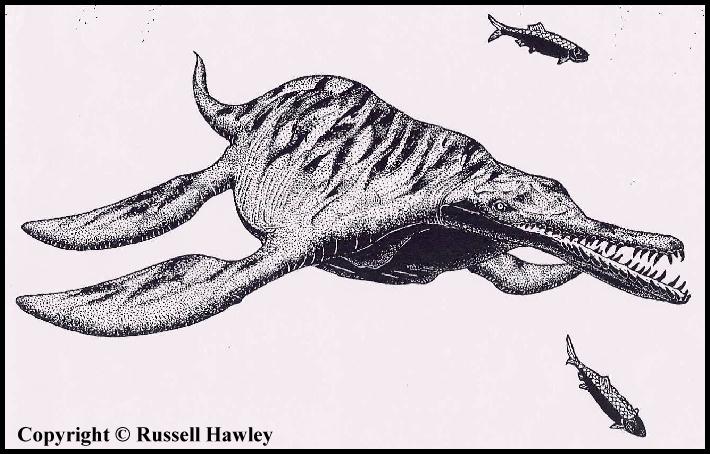 |
Plesiosaur swimming
reconstructed from skeletal analysis and experimental results
F. Sanders, K. Carpenter, B. Reed, and J. Reed.
Webpage Copyright © 2004-2010 by Mike Everhart
Webpage created 11/10/2004; updated 02/12/2010
LEFT: "Dolichorhynchops in
flight" is copyright © 2001 by Russell
Hawley. |
Those of you who were fortunate enough to attend the talk given by Frank
Sanders at the 2004 SVP meeting in Denver, Colorado, saw some very interesting videos of
underwater experiments that re-created the probable method by which plesiosaurs swam.
For those of you who weren't there or missed the session, Ken Carpenter has
graciously provided me a copy of one of the videos (.wmv). Click here to download the file.
The .wmv version of the video file is about 600 kb and may take a while to load
if you are on a dial up modem. If you cannot view the .wmv version, you may request a
.mpeg version (5.5 Mb) from Mike Everhart
The abstract is shown below and is available as a .pdf file.
PLESIOSAUR SWIMMING
.WMV VIDEO
| 2004 - Journal of Vertebrate
Paleontology 24(Supplement to 3): 108A-109A.
PLESIOSAUR SWIMMING RECONSTRUCTED FROM
SKELETAL ANALYSIS AND EXPERIMENTAL RESULTS
CLICK TITLE
ABOVE FOR THE .PDF VERSION OF ABSTRACT
SANDERS, Frank, CARPENTER, Kenneth, REED, Brian,
REED, Julia, Denver Museum of Natural History, Denver, CO
Three basic hypotheses have
been proposed for the swimming locomotion of plesiosaurs: rowing motion in which the
flippers move primarily in a horizontal plane; figure-eight motion (underwater flight) in
which the flippers move primarily in a vertical plane while continuously being rotated on
their longitudinal axes so as to generate thrust in a manner roughly analogous to that of
penguins or sea turtles; and a sea lion stroke in which the flippers move downward (and
backward (belly-ward)) to produce thrust. Within these hypotheses various proposals have
been made for synchronicity of the fore and rear flippers, as well as front flippers
propelled while the back flippers were passively employed for stabilization/steering.
These models for flipper motion have not been adequately constrained by limits of joint
articulation of fossil specimens. Furthermore, the proposed models for plesiosaur
propulsion have not previously been experimentally tested; given the inherent complexities
of underwater propulsion it is important that conclusions regarding plesiosaur swimming
should be confirmed by successful physical demonstrations.
We have reconstructed plesiosaur swimming by firstly taking into
account constraints on plesiosaur shoulder and hip joint articulation, and secondly by
testing (within the available range of motion) a variety of strokes with human swimmers
equipped with facsimile plesiosaur fins, including paired swimming to replicate the
action of four flippers at once. Significant results include: plesiosaur limbs are
constrained to mostly vertical motion with relatively less fore and aft freedom; in Plesiosaurus
fore flippers could move through a 55 deg arc and hind flippers only 35 deg
below horizontal; and back flippers did assist propulsion. Synchronous or near synchronous
movement of the front and back flippers has been found to work best. Propulsion is very
sensitive to details of flipper rotation during each stroke as well as small motions at
the flipper tips.
(©
2004 Society of Vertebrate Paleontology - Used with permission of the authors) |
SUGGESTED REFERENCES:
Godfrey, S.J. 1984. Plesiosaur subaqueous locomotion, a reappraisal. Neues Jahrbuch
fuer Geologie und Palaeontologie Abhandlungen (Stuttgart) (11):661-672.
Halstead, L.B. 1989. Plesiosaur locomotion. Journal of the Geological Society
146:37-40.
Lingham-Soliar, T. 2000. Plesiosaur locomotion: Is the four-wing problem real
or merely an atheoretical exercise? Neues Jahrbuch fuer Geologie und Palaeontologie
Abhandlungen (Stuttgart) 217:45-87.
O'Keefe, F.R. 2001. Ecomorphology of plesiosaur flipper geometry. Journal of
Evolutionary Biology 14:987-991.
Riess, J. and Frey, E. 1991. The evolution of underwater flight and the
locomotion of plesiosaurs. pp. 131-144, In Rayner, J. M. V. and R. J. Wooton
(eds.), Biomechanics in evolution. Cambridge University Press.Robinson, J. A. 1975.
The locomotion of plesiosaurs, Neues Jahrbuch fuer Geologie und Palaeontologie
Abhandlungen (Stuttgart) 149, 3:286-332.
Romer, A.S. 1974. Aquatic adaptations in reptiles - Primary or secondary?
Annals of the South African Museum 64:221-230.
Tarsitano, S. and Riess, J. 1982. Plesiosaur locomotion - underwater flight
versus rowing. Neues Jahrbuch fuer Geologie und Palaeontologie Abhandlungen (Stuttgart)
164:188-192.
Tarsitano, S. and Riess, J. 1982. Considerations concerning plesiosaur locomotion. Neues
Jahrbuch fuer Geologie und Palaeontologie Abhandlungen (Stuttgart) 164:193-194.
Taylor, M.A. 1981. Plesiosaurs - rigging and ballasting. Nature 290:628-629.


